The following factors are essential for a strong skeleton: proper nutrition, sufficient physical activity, absence of bad habits and timely treatment of diseases under the clear guidance of a qualified specialist. Unfortunately, with age, natural changes in the functioning of the body occur, which often lead to a decrease in bone density and the development of osteoporosis. Exercises to strengthen bones can prevent the development of this pathology and contribute to recovery.
Exercise to strengthen bones: things to remember
Exercise is included in the list of non-pharmacological methods for treatment of osteoporosis. There are several main groups of exercises for strengthening bones that have a beneficial effect on the condition of the skeleton:
- strength exercises;
- low impact exercises;
- high impact exercises;
- stretching exercises;
- functional exercises;
- exercises to improve balance.
In our previous article you can find an approximate plan and amounts of physical activity.
Remember that muscle pain that lasts for days after class – It is quite normal for people who are physically inactive or have not exercised for a long time. However, the actual performance of the exercises should not be accompanied by pain.
Pain during exercise indicates either incorrect execution or that the movement being performed is not suitable for you.
Technique for 5 Simple Exercises to Strengthen Bones
Patients with osteoporosis should approach any exercise with extreme caution and in consultation with their physician. The same goes for people with recent or frequent fractures.
The following are examples of bone-strengthening exercises that are simple to perform and with minimal risk of injury. The most suitable complex of physical activity is selected by a doctor who is well acquainted with the state of your health.
- Exercise for posture – corner stretch
Find a free corner in the apartment, stand in front of it and put your hands raised, as shown in the figure, against the wall.
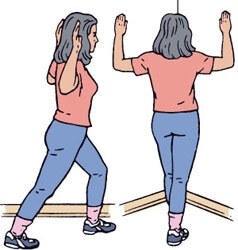
- put one leg forward, bending at the knee;
- leaning on the front leg, move your head and chest towards the wall;
- hold in the above position for half a minute;
- stand up straight;
- repeat on the other leg.
Do 2 times per leg thrice a week.
Benefits:
- shoulder stretch;
- Upper back alignment.
- Strengthening hips and back – hip abductor exercise
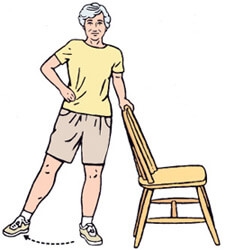
- stand straight and hold on to the back of a chair without bending your body at the waist or your legs at the knees;
- put your other hand on your hips, and lift the leg farthest from the chair (without bending);
- the toes point straight, while the arm and pelvis remain motionless;
- put your foot down;
- repeat 10 times;
- do the same on the other side.
Benefits:
- strengthens the thighs;
- improves balance.
- Lying Leg Raises
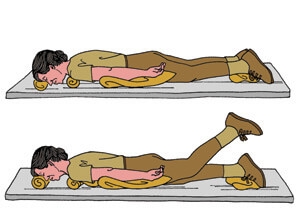
- lie face down;
- arms at sides;
- put rollers under your forehead and shoulders, and a pillow or towels under your stomach (for your convenience);
- bend your right leg slightly and lift it;
- don't tense your foot;
- perform 10 lifts;
- repeat with the other leg.
Perform 2-3 days a week.
Benefits:
- lumbar strengthening;
- buttocks strengthening;
- stretching the thigh muscles.
- Improving balance – toe and heel lifts
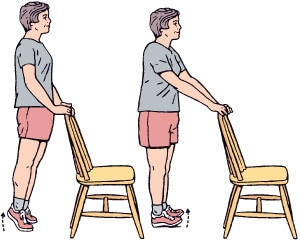
- Stand up straight and grab the back of the chair with your hands;
- without bending your legs and keeping your back straight, rise on your toes;
- go down;
- stand on your heels;
- repeat 10 times;
- do it daily.
Try to lean on the chair as little as possible – solely to maintain balance. If you balance well enough without support, you can do the exercise without a chair.
Benefits:
- strengthens the lower legs;
- improves balance.
- Exercise for balance – wall sliding
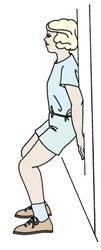
- Step back 1 foot away from the wall;
- turn your back to the wall;
- align your shoulders;
- put your buttocks, palms and shoulders against the wall;
- head should be as close to the wall as possible;
- pull in the belly;
- slowly slide up and down, bending your knees halfway;
- keep your back straight;
- do 10 times 2-3 times per week.
Benefits:
- strengthening hips, abdomen and back;
- back alignment;
- strengthening legs;
- better balance.
The exercises to strengthen the bones that estet-portal.com cited in this article are included in the list of movements that can be performed both for the prevention and treatment of osteoporosis.






Add a comment